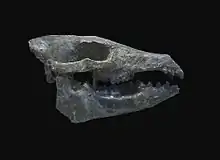Hyotheriinae
Hyotheriinae was a subfamily of even-toed ungulates that existed during the Miocene and Pliocene in Europe, Asia, and Africa.[1][2][3]
| Hyotheriinae | |
|---|---|
 | |
| A Hyotherium major skull, MNHN | |
| Scientific classification | |
| Kingdom: | |
| Phylum: | |
| Class: | |
| Order: | |
| Family: | |
| Subfamily: | Hyotheriinae Cope, 1888 |
Genera
- †Aureliachoerus Ginsburg, 1974 - Miocene, Europe [4]
- †Chicochoerus Orliac et al., 2006 - Miocene, Europe
- †Chleuastochoerus Pearson, 1928 - Miocene and Pliocene, Asia [5]
- †Hyotherium von Meyer, 1834 - Miocene, Europe and Asia [6]
- †Nguruwe Pickford, 1986 - (previously located in the subfamily of Kubanochoerinae)[7][8] Miocene, Africa [9]
- †Xenohyus Ginsburg, 1980 - Miocene, Europe [10]
References
- "Fossilworks: Hyotheriinae". fossilworks.org. Retrieved 2017-03-05.
- "Hyotheriinae - Overview - Encyclopedia of Life". Encyclopedia of Life. Retrieved 2017-03-05.
- "Hyotheriinae". tolweb.org. Retrieved 2017-03-05.
- "Fossilworks: Aureliachoerus". fossilworks.org. Retrieved 2017-03-05.
- "Fossilworks: Chleuastochoerus". fossilworks.org. Retrieved 2017-03-05.
- "Fossilworks: Hyotherium". fossilworks.org. Retrieved 2017-03-05.
- Maeva, J.O. (2009). "The differentiation of bunodont Listriodontinae (Mammalia, Suidae) of Africa: new data from Kalodirr and Moruorot, Kenya". Zoological Journal of the Linnean Society. 157 (3): 653–678. doi:10.1111/j.1096-3642.2008.00525.x.
- Maeva, J.O.; et al. (2010). "Phylogenetic relationships of the Suidae (Mammalia, Cetartiodactyla): new insights on the relationships within Suoidea". Zoologica Scripta. 39 (4): 315–330. doi:10.1111/j.1463-6409.2010.00431.x.
- "Fossilworks: Nguruwe". fossilworks.org. Retrieved 2017-03-05.
- "Fossilworks: Xenohyus". fossilworks.org. Retrieved 2017-03-05.
This article is issued from Wikipedia. The text is licensed under Creative Commons - Attribution - Sharealike. Additional terms may apply for the media files.